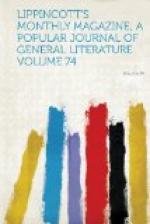“Indeed!” said Lady Arthur, “and have all the poor people got housed?”
“Most of them are at the station-house and various farm-houses. Mr. Forester, Mr. Ormiston’s son-in-law, started to bring up the last of them just as I started for you.”
“Well, I must say I have enjoyed it,” Lady Arthur said, “but how are we to get home to-night?”
“You’ll not get home to-night: you’ll have to stay at Cockhoolet, and be glad if you can get home to-morrow.”
“And where have you come from, and where are you going to?” she asked.
“I came from London—I have only been a week home from Australia—and I am on my way to Eildon. But here we are.”
And the hospitable doors of Cockhoolet were thrown wide, sending out a glow of light to welcome the belated travelers.
Mrs. Ormiston and her daughter, Mrs. Forester—who with her husband was on a visit at Cockhoolet—received them and took them to rooms where fires made what seemed tropical heat compared with the atmosphere in the glass case on the moor.
Miss Garscube was able for nothing but to go to bed, and Miss Adamson stayed with her in the room called Queen Mary’s, being the room that unfortunate lady occupied when she visited Cockhoolet.
On this night the castle must have thought old times had come back again, there was such a large and miscellaneous company beneath its roof. But where were the knights in armor, the courtiers in velvet and satin, the boars’ heads, the venison pasties, the wassail-bowls? Where were the stately dames in stiff brocade, the shaven priests, the fool in motley, the vassals, the yeomen in hodden gray and broad blue bonnet? Not there, certainly.
No doubt, Lady Arthur Eildon was a direct descendant of one of “the queen’s Maries,” but in her rusty black gown, her old black bonnet set awry on her head, her red face, her stout figure, made stouter by a sealskin jacket, you could not at a glance see the connection. The house of Eildon was pretty closely connected with the house of Stuart, but George Eildon in his tweed suit, waterproof and wideawake looked neither royal nor romantic. We may be almost sure that there was a fool or fools in the company, but they did not wear motley. In short, as yet it is difficult to connect the idea of romance with railway rugs, waterproofs, India-rubbers and wide-awakes and the steam of tea and coffee: three hundred years hence perhaps it may be possible. Who knows? But for all that, romances go on, we may be sure, whether people are clad in velvet or hodden gray.
Lady Arthur was framing a romance—a romance which had as much of the purely worldly in it as a romance can hold. She found that George was on his way to see his cousin, Lord Eildon, who within two days had had a severe access of illness. It seemed to her a matter of certainty that George would be duke of Eildon some day. If she had only had the capacity to have despatched that letter she had written when she believed she was dying, after him to Australia! Could she send it to him yet? She hesitated: she could hardly bring herself to compromise the dignity of Alice, and her own. She had a short talk with him before they separated for the night.




